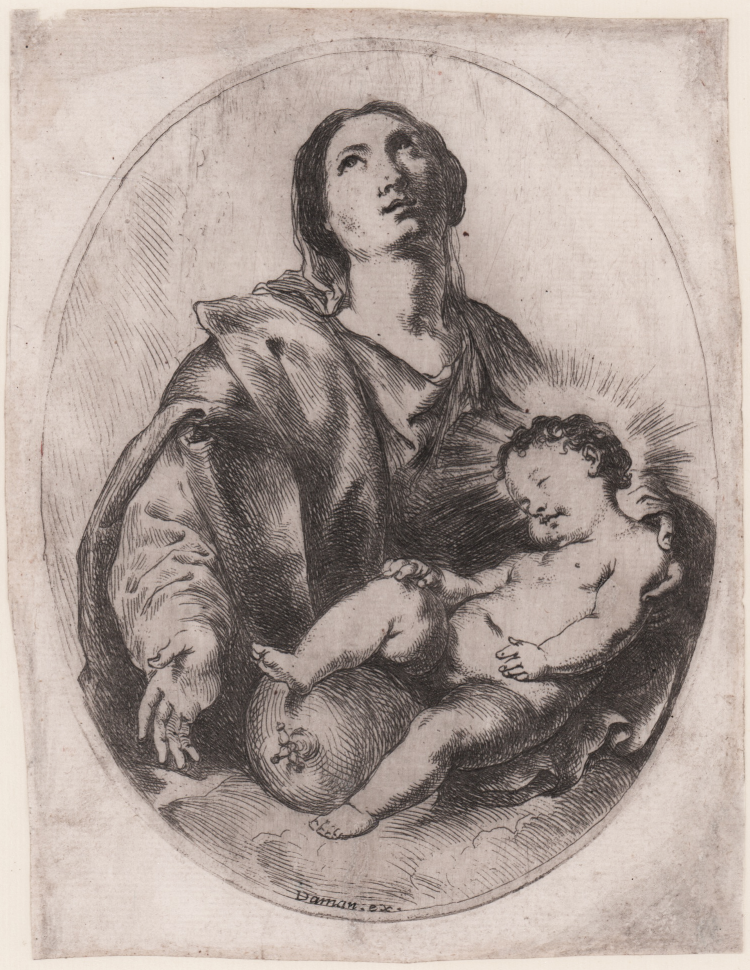



| Reference: | S37786 |
| Author | Bartolomeo BISCAINO |
| Year: | 1650 ca. |
| Measures: | 115 x 151 mm |



| Reference: | S37786 |
| Author | Bartolomeo BISCAINO |
| Year: | 1650 ca. |
| Measures: | 115 x 151 mm |
Etching, 1650 circa, not dated. Example of second state, inscribed in lower center “Daman. ex.”
Good example, printed on contemporary laid paper, with partial and unreadebale watermark, in very good condition.
The existence of first state has been hypothesized because the name of the printer Daman appears in darker ink than in the rest of the etching.
Very rare work.
|
TIB: 47.029 S2
|
Bartolomeo BISCAINO (Genova 1632 circa - 1657)
|
Scholar of his own father at first, the painter Giovanni Andrea, Bartolomeo went to study afterwards to the studio of Valerio Castello. From his second master he learned so well how to use colors and models that nowadays is still hard to determine if a painting has been realized by Bartolomeo or Valerio.
His main production, though, can be considered the graphic one, both through drawing (he was extremely versatile) and etching, his favourite technique. We know that, as a fringed and bright, is very close to that of Castiglione and can be considered Biscanio’s main characteristic. The neo-Mannerist style of this XVII century artist is also a sign of his admiration for Parmigianino, whom he met and tried to imitate.
Both his drawings and prints were looked with favour by collectors of XVIII and XIX centuries, especially because of their elegance and refinement.
His search for the colour effects, in particular in the white lead retouches on painted maps, can be found also in the chiaro-scuro of his engravings, which underlines the ability of the artist. The catalogue of his production is not wide (Bartsch lists about 40 pieces) for he died very young during the Black Death epidemic in Genua in 1657.
|
|
TIB: 47.029 S2
|
Bartolomeo BISCAINO (Genova 1632 circa - 1657)
|
Scholar of his own father at first, the painter Giovanni Andrea, Bartolomeo went to study afterwards to the studio of Valerio Castello. From his second master he learned so well how to use colors and models that nowadays is still hard to determine if a painting has been realized by Bartolomeo or Valerio.
His main production, though, can be considered the graphic one, both through drawing (he was extremely versatile) and etching, his favourite technique. We know that, as a fringed and bright, is very close to that of Castiglione and can be considered Biscanio’s main characteristic. The neo-Mannerist style of this XVII century artist is also a sign of his admiration for Parmigianino, whom he met and tried to imitate.
Both his drawings and prints were looked with favour by collectors of XVIII and XIX centuries, especially because of their elegance and refinement.
His search for the colour effects, in particular in the white lead retouches on painted maps, can be found also in the chiaro-scuro of his engravings, which underlines the ability of the artist. The catalogue of his production is not wide (Bartsch lists about 40 pieces) for he died very young during the Black Death epidemic in Genua in 1657.
|